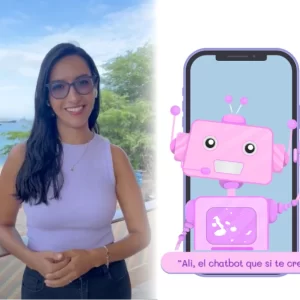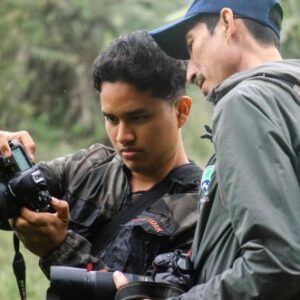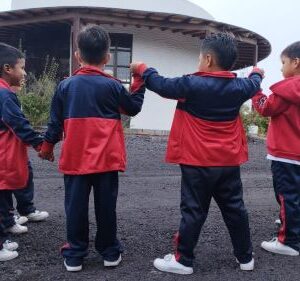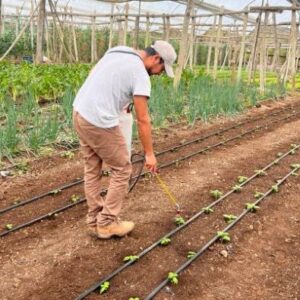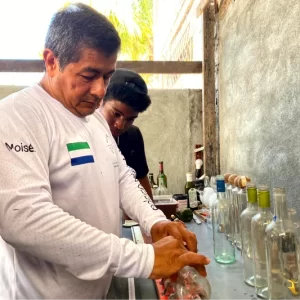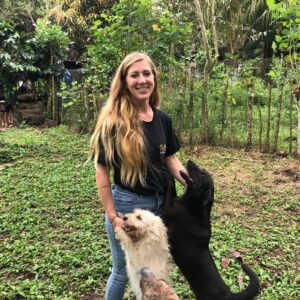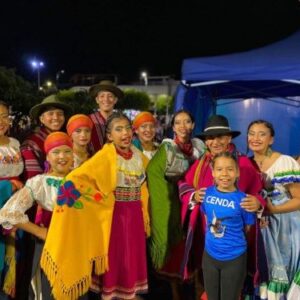I am Robert Clay Guerra Calderón, a professional Environmental Engineer, representative of the “Jóvenes en Acción” group and a volunteer with the Insular Front of the Galapagos Marine Reserve. I have participated in the water project carried out by the Fundación un Cambio por la Vida and Galápagos Conservation Trust.
Currently, I work as a Naturalist Guide in Galapagos and as a program coordinator for “El Mar nos Conecta.” Additionally, I am certified as a trainer by the Ocean for All Alliance, an initiative dedicated to organizing workshops focused on marine conservation.
My goal is to foster a culture of love and respect for the ocean among local youth, promoting their education and active participation in protecting our marine environment.
“It is difficult to protect what we do not know. That’s why it’s essential for the community to connect with and take ownership of aquatic spaces and bays. Enjoyment and recreation can be perfectly integrated with the protection and conservation of these ecosystems.”
The Galapagos Islands are a natural heritage of humanity, known worldwide for their astonishing biodiversity. Approximately a quarter of a million people visit the islands each year to enjoy the tourist attractions they offer.
However, many residents of the Galapagos are not familiar with many parts of the islands where they reside. This is due to lack of accessibility and the cost of visiting sites, as well as restrictions in certain areas. For example, while activities like kayaking in Puerto Ayora Bay are now permitted, there are still restrictions that hinder residents, particularly young people, from enjoying, exploring, and caring for the islands and replicating these experiences with visitors.
The cost of renting a kayak, which ranges from $15 to $20 per person, significantly limits community participation in water activities. Additionally, the lack of local guides who can provide accompaniment and key information during tours further hinders access to educational and recreational experiences in our marine spaces.
During the first phase of this project, we invested in new equipment to replace our obsolete kayaks, thereby expanding our program capacity and benefiting over 500 community members. Our free guided outings, lasting approximately 4 hours, foster responsible enjoyment of our coastal marine spaces while promoting their protection.
Thanks to the support of our community partners, we have a strategic storage space on the upper part of the island, which facilitates the logistics of our activities.
This high-impact social project seeks ongoing funding to continue empowering the community, fostering education and learning, and promoting the active conservation of our marine environment.
To empower a group of young people with aquatic skills, enabling them to educate the community about marine conservation.
To foster community awareness and stewardship of our bay.
To facilitate hands-on learning experiences through flora and fauna interpretation within the bay.
To actively engage in beach clean-ups, removing plastic pollution from our marine environment.
- 4.7: Through this project, the aim is for children, youth, and adults to gain knowledge and learn more about their environment in a practical way. By visiting and enjoying natural spaces, especially the sea, it promotes their protection.
- 8.9: The project promotes the implementation of sustainable tourism practices from the community, allowing the population itself to reflect the protection of the archipelago to visitors.
- 11.4: These programs, which aim to connect the community with its environment, utilize resources, and promote environmental protection and respect, foster the care of natural heritage.
- 14.1: When one becomes acquainted with spaces, they begin to care for and protect them, which is the goal of the project: for the community to take ownership of bays and coastal areas to reduce pollution generated in populated areas that ultimately ends up in the sea.
- 14.2: The project aims to promote the protection of bays, which in turn will protect marine and coastal ecosystems, primarily by raising awareness among the population about their proper use.
| Phase | Activity | Buget |
|---|---|---|
| PHASE 1 - Acquisition of equipment and materials | Purchase of 5 kayaks (2 single and 2 double), 10 life jackets, 10 whistles for life jackets and 2 lifebuoys. | $4000,00 FINANCED (MATCHED) |
| PHASE 2 – Initial Community educational experiential outings | Development of 5 community oceanic experiential experiences | $1000,00 FINANCED (MATCHED) |
| PHASE 3 - Volunteer training | Two-month first aid skills development program for local youth. | $1650,00 REQUIRE FUNDING (The value includes 10% of Overhead for the administration of the Co-Galapagos initiative) |
| PHASE 4 – Equipment acquisition | Purchase of life jackets and snorkeling equipment for children and adults. Duration: 2 months. | $3850,00 REQUIRE FUNDING (The value includes 10% of Overhead for the administration of the Co-Galapagos initiative) |





